Psychology Assignment: Training Programs and Organizational Stress
VerifiedAdded on 2022/09/07
|6
|1262
|15
Report
AI Summary
This psychology assignment report delves into the impact of stressors on organizations, exploring how factors like job security fears and high workloads contribute to employee dissatisfaction, absenteeism, and reduced productivity. It examines effective strategies for managing organizational stress, including clear communication, performance reviews, and lifestyle coaching. The report outlines the benefits of individual training programs, such as improved teamwork and conflict management skills, and compares different training levels including on-the-job training, job rotation, and classroom lectures. Furthermore, it details methods for selecting new employees, emphasizing the importance of a bias-free recruitment process to meet organizational goals. The assignment provides a comprehensive overview of key concepts in industrial organizational psychology, offering practical insights into workplace dynamics and employee development.
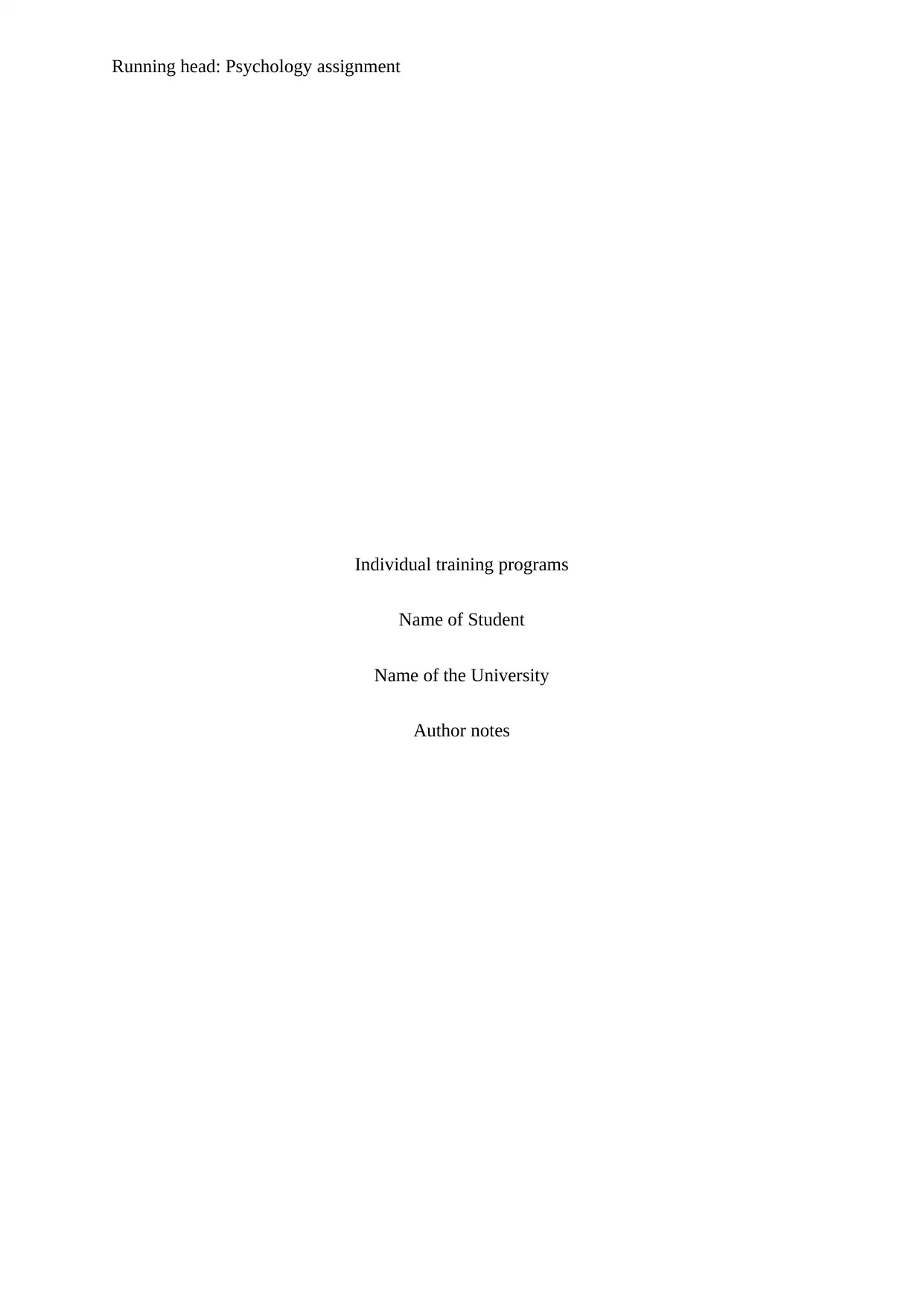
Running head: Psychology assignment
Individual training programs
Name of Student
Name of the University
Author notes
Individual training programs
Name of Student
Name of the University
Author notes
Paraphrase This Document
Need a fresh take? Get an instant paraphrase of this document with our AI Paraphraser
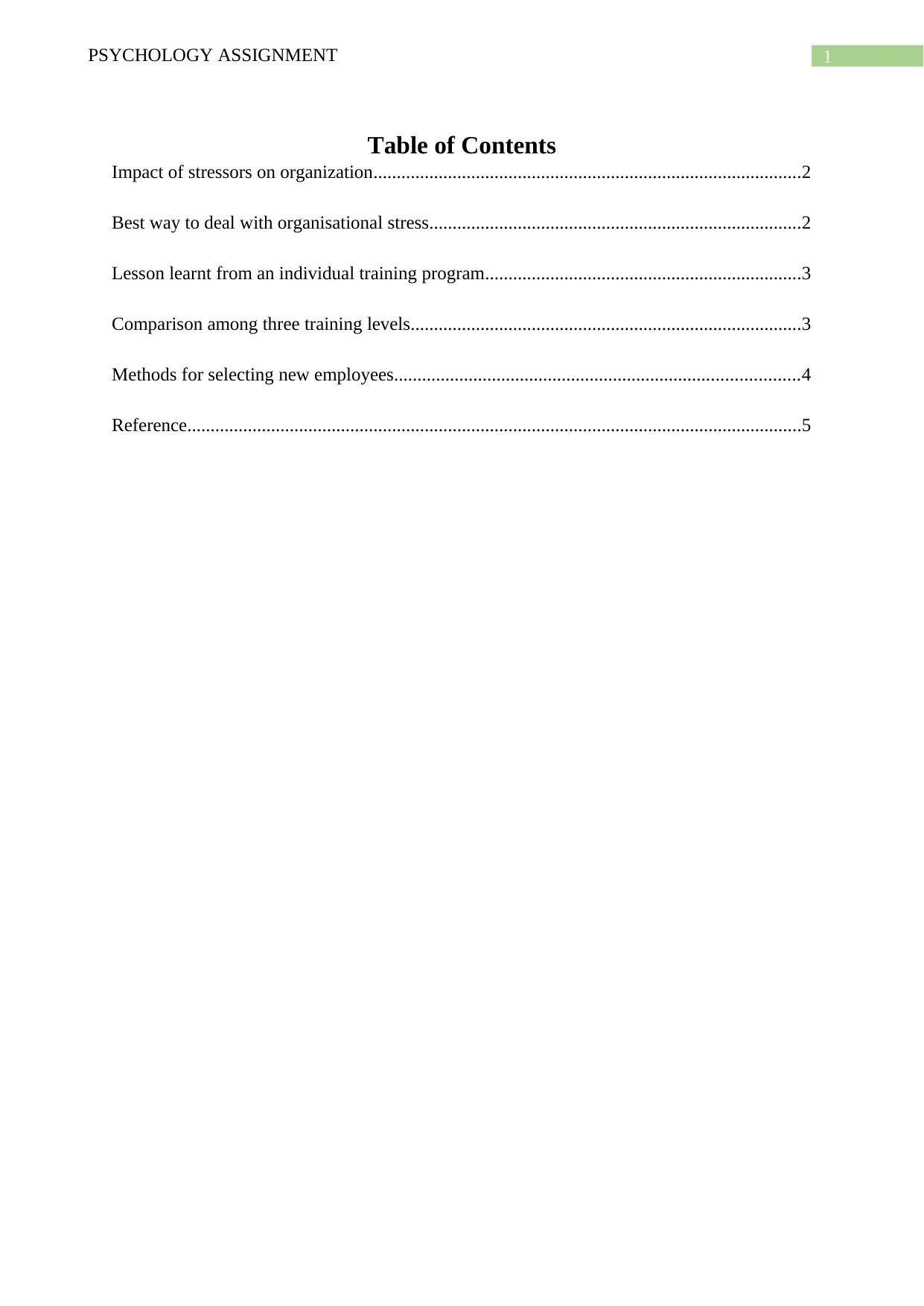
1PSYCHOLOGY ASSIGNMENT
Table of Contents
Impact of stressors on organization............................................................................................2
Best way to deal with organisational stress................................................................................2
Lesson learnt from an individual training program....................................................................3
Comparison among three training levels....................................................................................3
Methods for selecting new employees.......................................................................................4
Reference....................................................................................................................................5
Table of Contents
Impact of stressors on organization............................................................................................2
Best way to deal with organisational stress................................................................................2
Lesson learnt from an individual training program....................................................................3
Comparison among three training levels....................................................................................3
Methods for selecting new employees.......................................................................................4
Reference....................................................................................................................................5
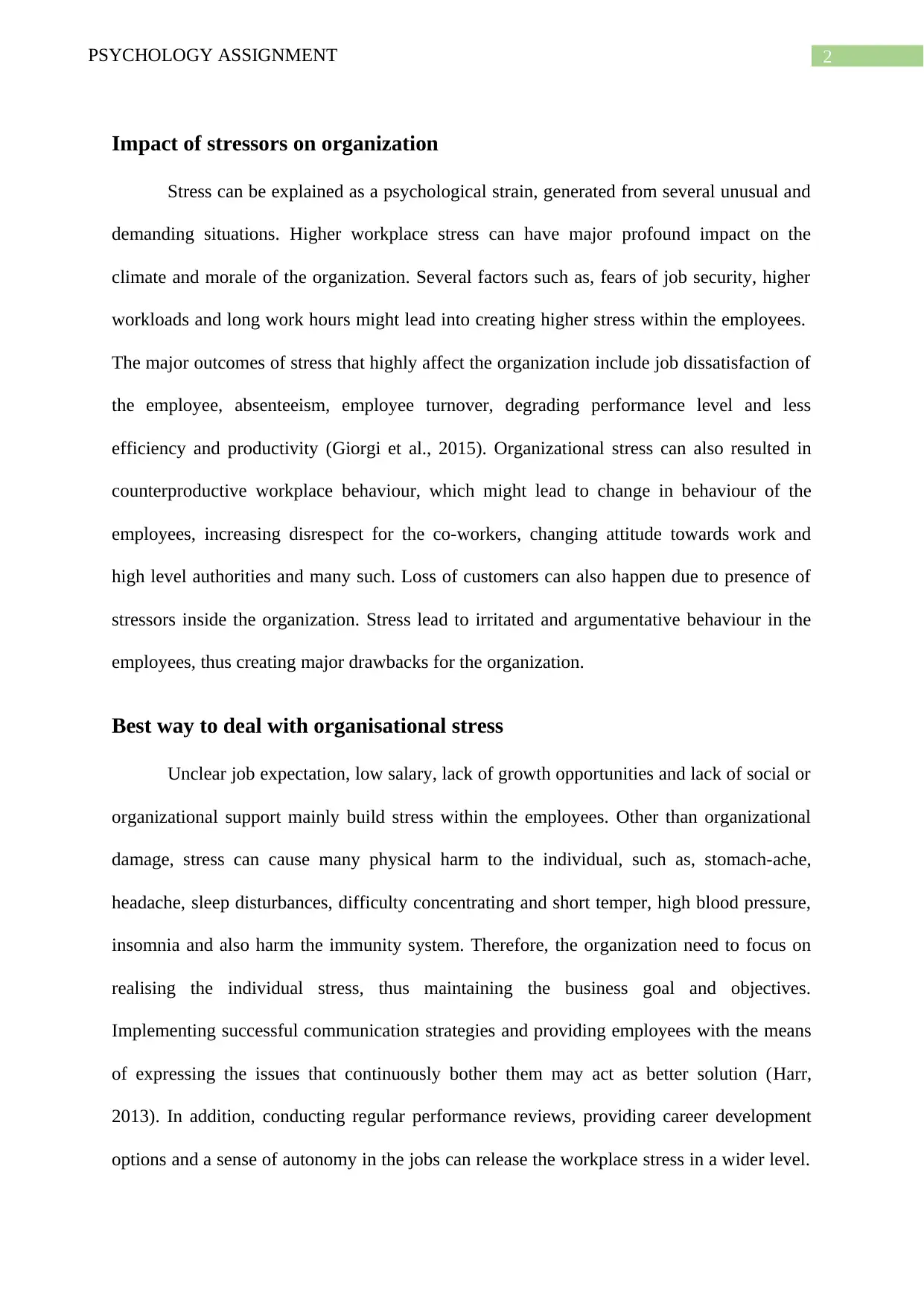
2PSYCHOLOGY ASSIGNMENT
Impact of stressors on organization
Stress can be explained as a psychological strain, generated from several unusual and
demanding situations. Higher workplace stress can have major profound impact on the
climate and morale of the organization. Several factors such as, fears of job security, higher
workloads and long work hours might lead into creating higher stress within the employees.
The major outcomes of stress that highly affect the organization include job dissatisfaction of
the employee, absenteeism, employee turnover, degrading performance level and less
efficiency and productivity (Giorgi et al., 2015). Organizational stress can also resulted in
counterproductive workplace behaviour, which might lead to change in behaviour of the
employees, increasing disrespect for the co-workers, changing attitude towards work and
high level authorities and many such. Loss of customers can also happen due to presence of
stressors inside the organization. Stress lead to irritated and argumentative behaviour in the
employees, thus creating major drawbacks for the organization.
Best way to deal with organisational stress
Unclear job expectation, low salary, lack of growth opportunities and lack of social or
organizational support mainly build stress within the employees. Other than organizational
damage, stress can cause many physical harm to the individual, such as, stomach-ache,
headache, sleep disturbances, difficulty concentrating and short temper, high blood pressure,
insomnia and also harm the immunity system. Therefore, the organization need to focus on
realising the individual stress, thus maintaining the business goal and objectives.
Implementing successful communication strategies and providing employees with the means
of expressing the issues that continuously bother them may act as better solution (Harr,
2013). In addition, conducting regular performance reviews, providing career development
options and a sense of autonomy in the jobs can release the workplace stress in a wider level.
Impact of stressors on organization
Stress can be explained as a psychological strain, generated from several unusual and
demanding situations. Higher workplace stress can have major profound impact on the
climate and morale of the organization. Several factors such as, fears of job security, higher
workloads and long work hours might lead into creating higher stress within the employees.
The major outcomes of stress that highly affect the organization include job dissatisfaction of
the employee, absenteeism, employee turnover, degrading performance level and less
efficiency and productivity (Giorgi et al., 2015). Organizational stress can also resulted in
counterproductive workplace behaviour, which might lead to change in behaviour of the
employees, increasing disrespect for the co-workers, changing attitude towards work and
high level authorities and many such. Loss of customers can also happen due to presence of
stressors inside the organization. Stress lead to irritated and argumentative behaviour in the
employees, thus creating major drawbacks for the organization.
Best way to deal with organisational stress
Unclear job expectation, low salary, lack of growth opportunities and lack of social or
organizational support mainly build stress within the employees. Other than organizational
damage, stress can cause many physical harm to the individual, such as, stomach-ache,
headache, sleep disturbances, difficulty concentrating and short temper, high blood pressure,
insomnia and also harm the immunity system. Therefore, the organization need to focus on
realising the individual stress, thus maintaining the business goal and objectives.
Implementing successful communication strategies and providing employees with the means
of expressing the issues that continuously bother them may act as better solution (Harr,
2013). In addition, conducting regular performance reviews, providing career development
options and a sense of autonomy in the jobs can release the workplace stress in a wider level.
⊘ This is a preview!⊘
Do you want full access?
Subscribe today to unlock all pages.

Trusted by 1+ million students worldwide
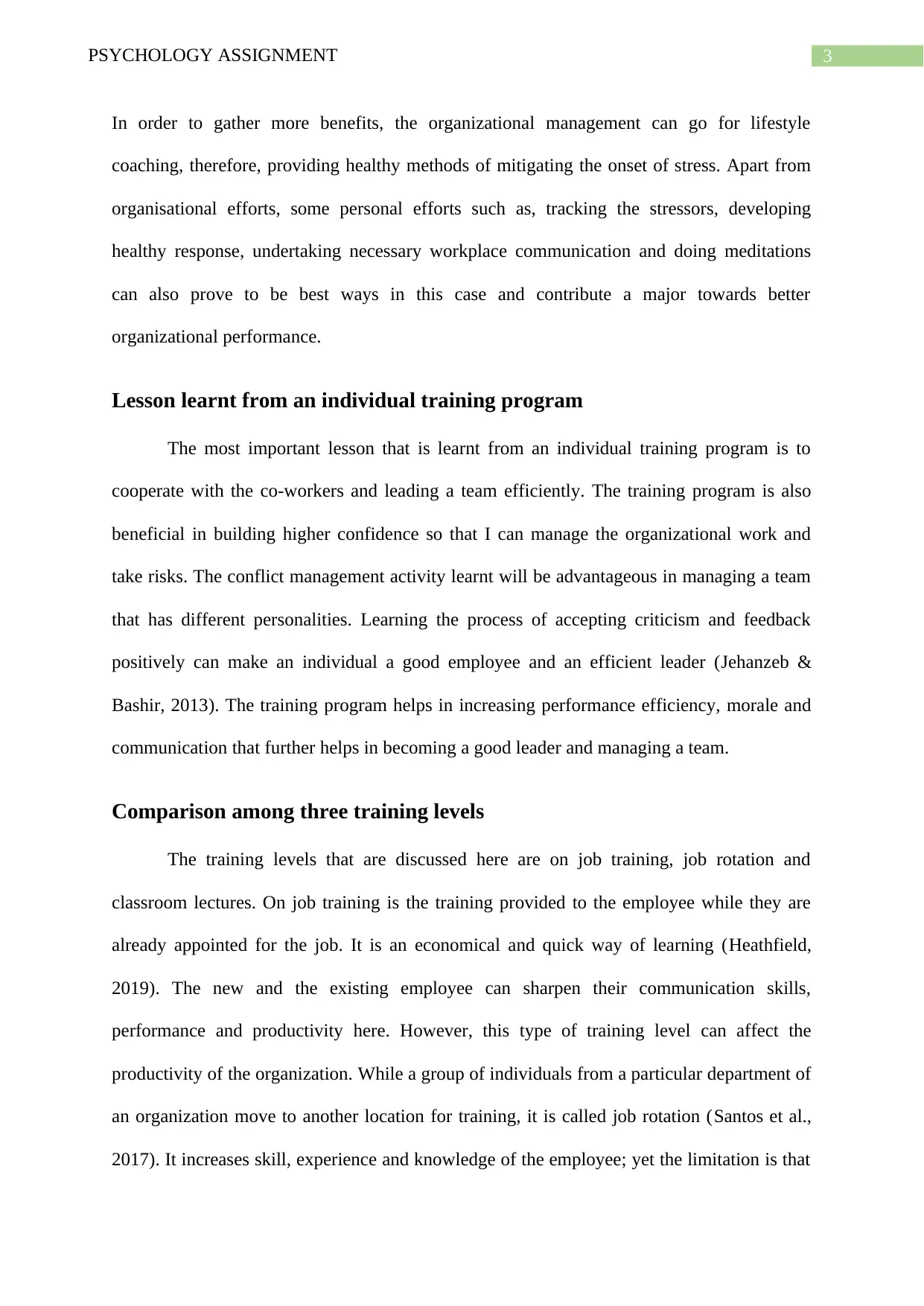
3PSYCHOLOGY ASSIGNMENT
In order to gather more benefits, the organizational management can go for lifestyle
coaching, therefore, providing healthy methods of mitigating the onset of stress. Apart from
organisational efforts, some personal efforts such as, tracking the stressors, developing
healthy response, undertaking necessary workplace communication and doing meditations
can also prove to be best ways in this case and contribute a major towards better
organizational performance.
Lesson learnt from an individual training program
The most important lesson that is learnt from an individual training program is to
cooperate with the co-workers and leading a team efficiently. The training program is also
beneficial in building higher confidence so that I can manage the organizational work and
take risks. The conflict management activity learnt will be advantageous in managing a team
that has different personalities. Learning the process of accepting criticism and feedback
positively can make an individual a good employee and an efficient leader (Jehanzeb &
Bashir, 2013). The training program helps in increasing performance efficiency, morale and
communication that further helps in becoming a good leader and managing a team.
Comparison among three training levels
The training levels that are discussed here are on job training, job rotation and
classroom lectures. On job training is the training provided to the employee while they are
already appointed for the job. It is an economical and quick way of learning (Heathfield,
2019). The new and the existing employee can sharpen their communication skills,
performance and productivity here. However, this type of training level can affect the
productivity of the organization. While a group of individuals from a particular department of
an organization move to another location for training, it is called job rotation (Santos et al.,
2017). It increases skill, experience and knowledge of the employee; yet the limitation is that
In order to gather more benefits, the organizational management can go for lifestyle
coaching, therefore, providing healthy methods of mitigating the onset of stress. Apart from
organisational efforts, some personal efforts such as, tracking the stressors, developing
healthy response, undertaking necessary workplace communication and doing meditations
can also prove to be best ways in this case and contribute a major towards better
organizational performance.
Lesson learnt from an individual training program
The most important lesson that is learnt from an individual training program is to
cooperate with the co-workers and leading a team efficiently. The training program is also
beneficial in building higher confidence so that I can manage the organizational work and
take risks. The conflict management activity learnt will be advantageous in managing a team
that has different personalities. Learning the process of accepting criticism and feedback
positively can make an individual a good employee and an efficient leader (Jehanzeb &
Bashir, 2013). The training program helps in increasing performance efficiency, morale and
communication that further helps in becoming a good leader and managing a team.
Comparison among three training levels
The training levels that are discussed here are on job training, job rotation and
classroom lectures. On job training is the training provided to the employee while they are
already appointed for the job. It is an economical and quick way of learning (Heathfield,
2019). The new and the existing employee can sharpen their communication skills,
performance and productivity here. However, this type of training level can affect the
productivity of the organization. While a group of individuals from a particular department of
an organization move to another location for training, it is called job rotation (Santos et al.,
2017). It increases skill, experience and knowledge of the employee; yet the limitation is that
Paraphrase This Document
Need a fresh take? Get an instant paraphrase of this document with our AI Paraphraser
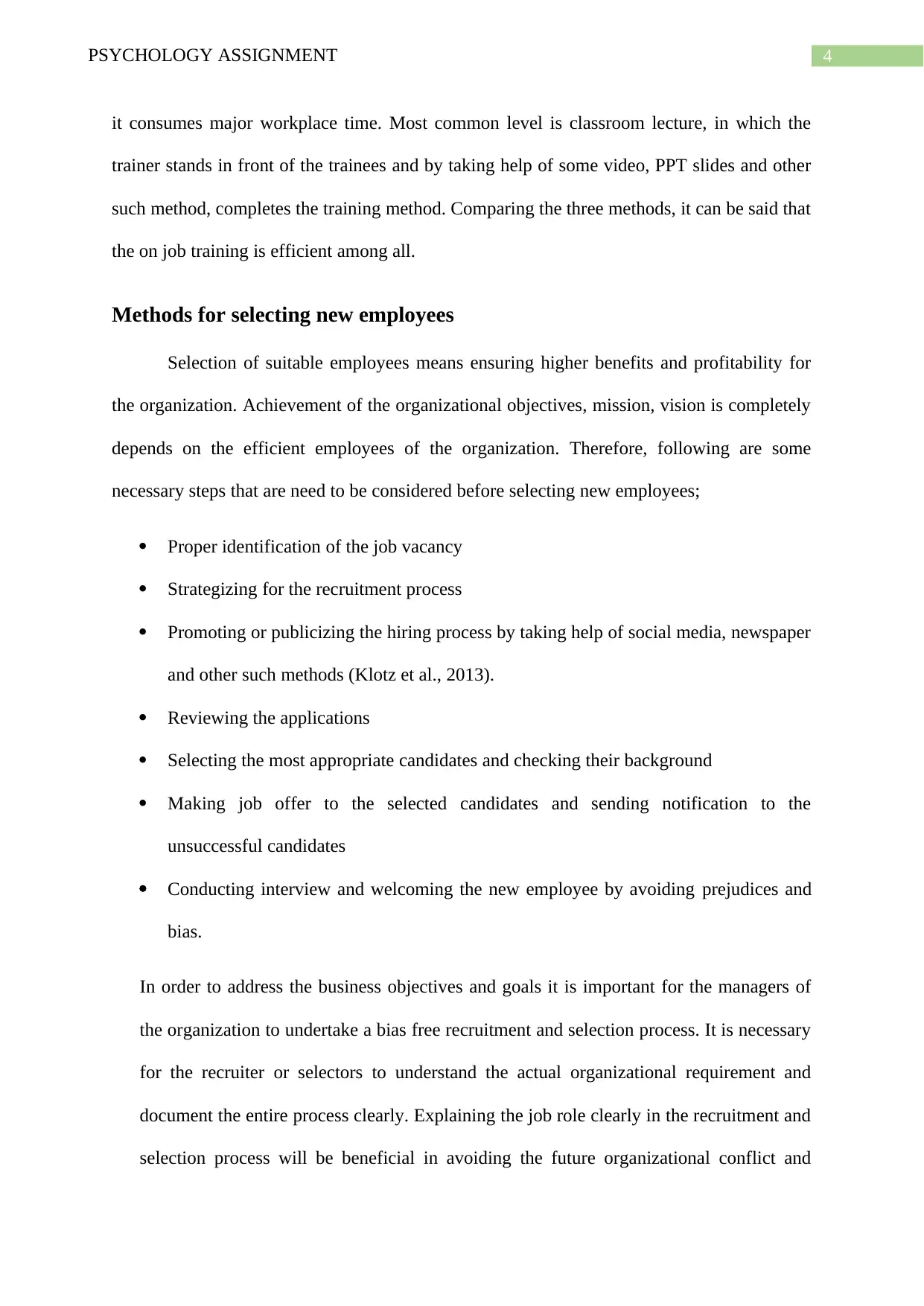
4PSYCHOLOGY ASSIGNMENT
it consumes major workplace time. Most common level is classroom lecture, in which the
trainer stands in front of the trainees and by taking help of some video, PPT slides and other
such method, completes the training method. Comparing the three methods, it can be said that
the on job training is efficient among all.
Methods for selecting new employees
Selection of suitable employees means ensuring higher benefits and profitability for
the organization. Achievement of the organizational objectives, mission, vision is completely
depends on the efficient employees of the organization. Therefore, following are some
necessary steps that are need to be considered before selecting new employees;
Proper identification of the job vacancy
Strategizing for the recruitment process
Promoting or publicizing the hiring process by taking help of social media, newspaper
and other such methods (Klotz et al., 2013).
Reviewing the applications
Selecting the most appropriate candidates and checking their background
Making job offer to the selected candidates and sending notification to the
unsuccessful candidates
Conducting interview and welcoming the new employee by avoiding prejudices and
bias.
In order to address the business objectives and goals it is important for the managers of
the organization to undertake a bias free recruitment and selection process. It is necessary
for the recruiter or selectors to understand the actual organizational requirement and
document the entire process clearly. Explaining the job role clearly in the recruitment and
selection process will be beneficial in avoiding the future organizational conflict and
it consumes major workplace time. Most common level is classroom lecture, in which the
trainer stands in front of the trainees and by taking help of some video, PPT slides and other
such method, completes the training method. Comparing the three methods, it can be said that
the on job training is efficient among all.
Methods for selecting new employees
Selection of suitable employees means ensuring higher benefits and profitability for
the organization. Achievement of the organizational objectives, mission, vision is completely
depends on the efficient employees of the organization. Therefore, following are some
necessary steps that are need to be considered before selecting new employees;
Proper identification of the job vacancy
Strategizing for the recruitment process
Promoting or publicizing the hiring process by taking help of social media, newspaper
and other such methods (Klotz et al., 2013).
Reviewing the applications
Selecting the most appropriate candidates and checking their background
Making job offer to the selected candidates and sending notification to the
unsuccessful candidates
Conducting interview and welcoming the new employee by avoiding prejudices and
bias.
In order to address the business objectives and goals it is important for the managers of
the organization to undertake a bias free recruitment and selection process. It is necessary
for the recruiter or selectors to understand the actual organizational requirement and
document the entire process clearly. Explaining the job role clearly in the recruitment and
selection process will be beneficial in avoiding the future organizational conflict and
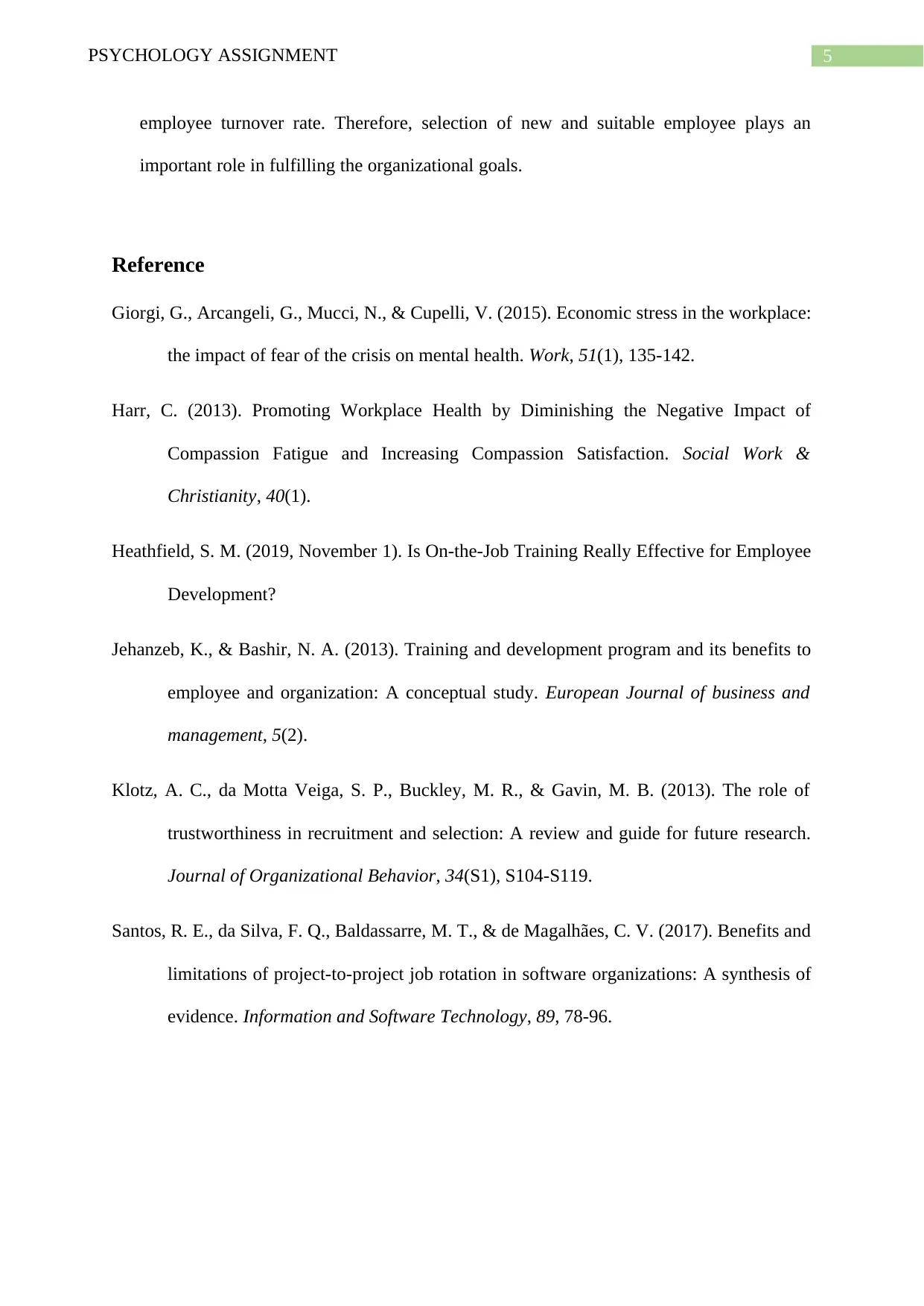
5PSYCHOLOGY ASSIGNMENT
employee turnover rate. Therefore, selection of new and suitable employee plays an
important role in fulfilling the organizational goals.
Reference
Giorgi, G., Arcangeli, G., Mucci, N., & Cupelli, V. (2015). Economic stress in the workplace:
the impact of fear of the crisis on mental health. Work, 51(1), 135-142.
Harr, C. (2013). Promoting Workplace Health by Diminishing the Negative Impact of
Compassion Fatigue and Increasing Compassion Satisfaction. Social Work &
Christianity, 40(1).
Heathfield, S. M. (2019, November 1). Is On-the-Job Training Really Effective for Employee
Development?
Jehanzeb, K., & Bashir, N. A. (2013). Training and development program and its benefits to
employee and organization: A conceptual study. European Journal of business and
management, 5(2).
Klotz, A. C., da Motta Veiga, S. P., Buckley, M. R., & Gavin, M. B. (2013). The role of
trustworthiness in recruitment and selection: A review and guide for future research.
Journal of Organizational Behavior, 34(S1), S104-S119.
Santos, R. E., da Silva, F. Q., Baldassarre, M. T., & de Magalhães, C. V. (2017). Benefits and
limitations of project-to-project job rotation in software organizations: A synthesis of
evidence. Information and Software Technology, 89, 78-96.
employee turnover rate. Therefore, selection of new and suitable employee plays an
important role in fulfilling the organizational goals.
Reference
Giorgi, G., Arcangeli, G., Mucci, N., & Cupelli, V. (2015). Economic stress in the workplace:
the impact of fear of the crisis on mental health. Work, 51(1), 135-142.
Harr, C. (2013). Promoting Workplace Health by Diminishing the Negative Impact of
Compassion Fatigue and Increasing Compassion Satisfaction. Social Work &
Christianity, 40(1).
Heathfield, S. M. (2019, November 1). Is On-the-Job Training Really Effective for Employee
Development?
Jehanzeb, K., & Bashir, N. A. (2013). Training and development program and its benefits to
employee and organization: A conceptual study. European Journal of business and
management, 5(2).
Klotz, A. C., da Motta Veiga, S. P., Buckley, M. R., & Gavin, M. B. (2013). The role of
trustworthiness in recruitment and selection: A review and guide for future research.
Journal of Organizational Behavior, 34(S1), S104-S119.
Santos, R. E., da Silva, F. Q., Baldassarre, M. T., & de Magalhães, C. V. (2017). Benefits and
limitations of project-to-project job rotation in software organizations: A synthesis of
evidence. Information and Software Technology, 89, 78-96.
⊘ This is a preview!⊘
Do you want full access?
Subscribe today to unlock all pages.

Trusted by 1+ million students worldwide
1 out of 6
Related Documents
Your All-in-One AI-Powered Toolkit for Academic Success.
+13062052269
info@desklib.com
Available 24*7 on WhatsApp / Email
![[object Object]](/_next/static/media/star-bottom.7253800d.svg)
Unlock your academic potential
Copyright © 2020–2025 A2Z Services. All Rights Reserved. Developed and managed by ZUCOL.





